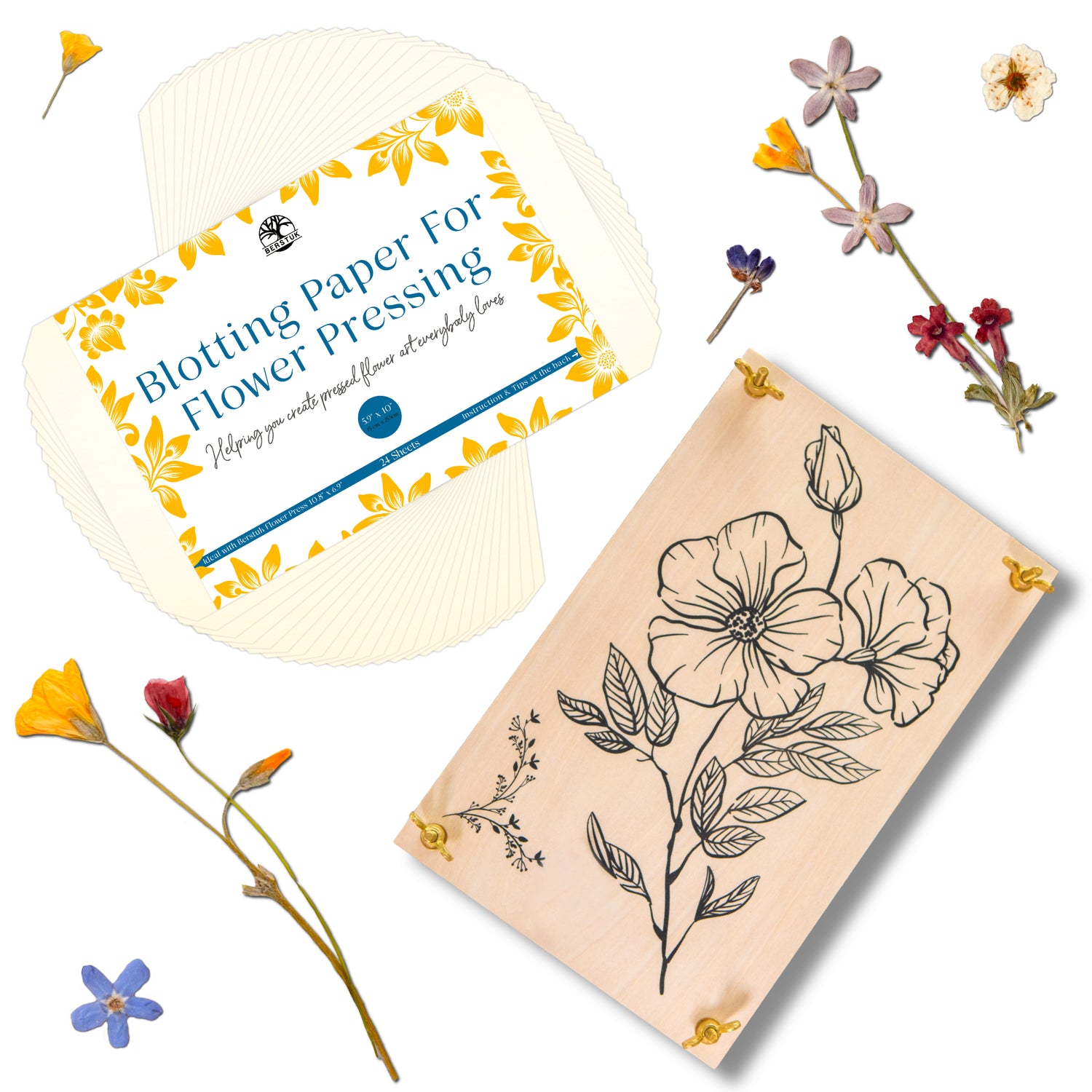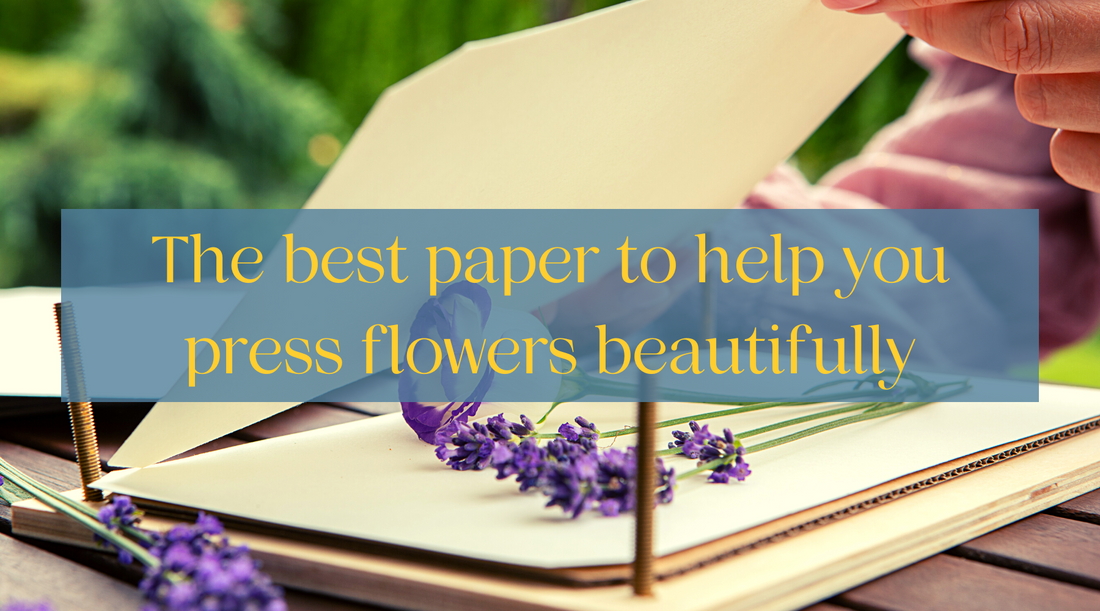What is blotter paper (also called blotting paper)? Is there a difference between blotting paper for face and blotting paper for flowers?
Blotting paper for the face and blotting paper for flower pressing are similar in that they are both types of absorbent paper that are used to remove excess moisture and oil. However, there are also some key differences between the two.
Blotting paper for the face is specifically designed to be used on skin. It is made of a lightweight paper that is infused with a powdery substance, usually rice or talc powder, that helps to absorb excess oil and shine on the skin. It is convenient, and it can be used on the go, when you don't have access to a mirror, it gives a quick and refreshing touch up.
On the other hand, blotting paper for flower pressing is designed to be used on flowers. It is made of a variety of materials including cellulose, cotton, and linen, and is designed to be highly absorbent in order to remove excess moisture from flowers and preserve their shape, color, and detail. This is achieved by sandwiching the flowers between layers of blotter paper and applying pressure to squeeze out the excess moisture. It's ideal for craft projects, art or for display.
While both types of blotting paper serve similar purposes, they are designed for different uses and therefore have different properties. When looking for blotting paper, be sure to choose the right one for the task you have in mind, whether it's for your face or for your flowers.
When you press flowers using blotter paper, the moisture is drawn out of the flowers and into the blotter paper. The improved absorbency of blotter paper also helps to capture and retain the detail of the flowers.
As mentioned above, one of the key advantages of using blotter paper for flower pressing is its absorbency. By removing excess moisture from the flowers, blotter paper allows them to dry more quickly and retain their shape and color. This can be especially useful if you are working with flowers that are prone to wilting or have a high water content.
Warning
It is important to note that not all papers advertised as blotting paper for flower pressing are true blotting papers. In fact, many papers on the market that claim to be "blotting paper" are not absorbent enough to effectively remove moisture from flowers and preserve them properly.
When selecting blotting paper for flower pressing, it is important to be careful and make sure that you are using a high-quality, absorbent paper that is specifically designed for this purpose. Avoid buying cheap paper that is labeled as "blotting paper" without a proper research, it may not have the characteristics needed for flower pressing.
It is best to purchase blotting paper from reputable art or craft suppliers or looking for reviews and feedback from other flower pressers, to ensure that you are getting a true blotting paper that will give you the best results for your flower pressing projects.
Blotting Paper vs Printing Paper vs Wax Paper vs Parchment Paper vs Japanese Paper (Washi) vs Paper Towel
Each type of paper has its own unique advantages and disadvantages, so it's important to understand the differences and choose the right paper for your project.
Printing paper
Standard printing paper is another option for flower pressing. It is widely available, and it is an affordable alternative to blotting paper. Standard printing paper is also acid-free, which means it will not yellow or damage the flowers over time.
One of the main disadvantages of using standard printing paper is that it is not as absorbent as blotting paper, so it may not remove as much moisture from the flowers. As a result of this increases the chances of your blooms getting moldy. Additionally, standard printing paper is not as thick and durable as blotting paper, so once the paper has been used, you can't really reuse it for another batch of flowers.
Wax paper
Wax paper is another option for flower pressing. It is widely available and affordable. It is a thin paper that is coated with a thin layer of wax, which makes it moisture-resistant. This can help to protect the flowers from humidity, dust and other environmental factors. But pretty much it.
One of the main disadvantages of using wax paper is that it is not absorbent, so it will not remove/soak up moisture from the flowers. Additionally, the wax coating can sometimes stick to the flowers, which can make it difficult to remove the flowers from the wax paper once they are pressed. I would not recommend to use wax paper to press flowers, so best to use it to protect your pressed blooms only.
Parchment paper
Another option to consider when pressing flowers is parchment paper. Parchment paper is similar to wax paper in that it is moisture-resistant, but it is also heat-resistant and oven safe. This makes it a great option for pressing flowers using heat, such as using an iron or a microwave.
Parchment paper also provides a barrier between the flowers and any surface they are pressed on, which can prevent ink transfer or other stains from transferring to the flowers. Additionally, it is widely available and affordable. However, it is also not as absorbent as blotting paper, so it may not remove as much moisture from the flowers.
Japanese paper (Washi)
Our next option for pressing flowers is Japanese paper, also known as washi. Washi is a traditional Japanese paper that is made from the inner bark of the paper mulberry tree. It is known for its strength, durability, and beauty. It is also acid-free and lignin-free, which means it will not yellow or damage the flowers over time.
However, it is not as absorbent as blotting paper, so it may not remove as much moisture from the flowers. Additionally, it is not as widely available and can be relatively expensive compared to all options listed above.
Paper Kitchen Towel
Did you know that kitchen towels can also be used as a pressing tool? These handy little things are absorbent, inexpensive and you probably already have some at home!
But here's the thing, they often have a cute little flower design on them which can leave a visible imprint on your pressed flowers. Yet don't let that stop you, if you're using them for personal use it might add a cute touch to it. Just something to keep in mind if you're planning to use them for decorative purposes.
Summary
While there are other types of paper that can be used for flower pressing, such as parchment paper, printing paper, wax paper, Japanese paper and paper towel, each one of them has their own unique advantages and disadvantages for flower pressing. Blotter paper, however, is the best option for removing excess moisture from the flowers and preserving their color, shape and detail.
In conclusion, if you are looking for a paper that will help you to preserve flowers, blotter paper for flower pressing is the way to go. Its absorbency properties will help you to dry your flowers quickly, retain their shape and color, and keep their details. It is cost-effective, reusable and lightweight, making it an excellent choice for flower pressing. No matter if you're a professional or just a beginner, Blotter paper will help you to create beautiful and unique flower art that you'll be able to admire for years to come.
If you want to find other ways to help preserve the color of your blooms, be sure to read our post How to protect flowers by sealing them.
Don't miss out on exclusive flower pressing tips, discounts, and more! Sign up for our mailing list now and join our community of flower enthusiasts who are always one step ahead. Click HERE to perfect your pressed flower art.




